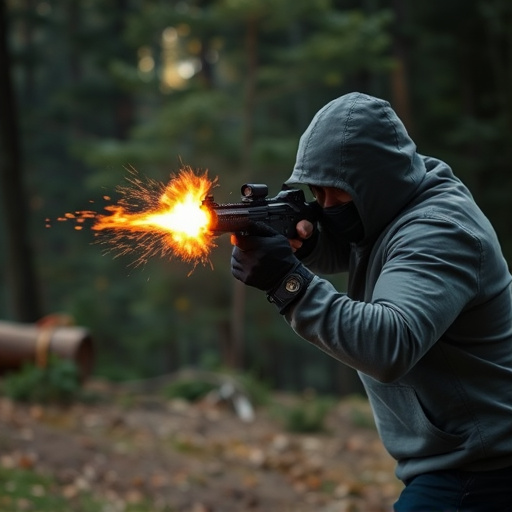Stun gun electrode spacing is critical for effectiveness in urban safety, with narrow gaps (1-2 inches) delivering concentrated charges for close ranges and wider gaps providing longer-reaching but less intense shocks. For bustling city environments, best stun guns for urban safety should have strategic electrode placement to maximize contact and reliably incapacitate targets. Features like compact size, high visibility, durability, and robust construction make these stun guns easily accessible yet discreet in challenging urban conditions, as supported by real-world case studies demonstrating their effectiveness.
“Uncover the critical aspect of stun gun electrode spacing—a key factor in urban safety. This comprehensive guide explores the science behind the spacing, its impact on stun gun effectiveness, and how it influences real-world applications. We delve into the factors affecting electrode placement, providing insights for professionals seeking the best stun guns tailored to urban environments. Discover the latest case studies, revealing successful outcomes and lessons learned in navigating this essential safety tool.”
- Understanding Stun Gun Electrode Spacing: The Science Behind It
- Factors Affecting the Effectiveness of Stun Gun Electrode Spacing
- Best Practices for Choosing Stun Guns Based on Urban Safety Needs
- Case Studies: Real-World Applications and Their Outcomes
Understanding Stun Gun Electrode Spacing: The Science Behind It
Stun gun electrode spacing is a critical factor in determining the effectiveness of a stun device, especially when considering its primary purpose: to incapacitate an attacker for a crucial period, enabling escape or assistance. The science behind this concept lies in the electrical current flow and its impact on the human body. Stun guns use two electrodes—one negative and one positive—to deliver an electric shock. The distance between these electrodes influences the intensity and spread of the current, which is key to causing muscular spasms and temporary paralysis.
For urban safety, where quick and reliable protection is essential, choosing the best stun guns involves understanding this electrode spacing. Narrower spacing can result in a more concentrated charge, increasing the chance of a successful incapacitation at closer ranges. Conversely, wider spacing allows for a slightly less intense but longer-reaching shock. The optimal spacing varies based on factors like device design and intended use cases, particularly when considering self-defense scenarios in urban environments where distance and angle can vary greatly.
Factors Affecting the Effectiveness of Stun Gun Electrode Spacing
The effectiveness of a stun gun’s electrode spacing is influenced by several key factors, especially when considering their utility in urban safety scenarios. One critical aspect is the size and layout of the target area. For best stun guns designed for urban safety, electrodes should be strategically placed to maximize contact with the subject, regardless of their position or movement. This ensures a more reliable incapacitation, crucial in bustling city environments where quick response times are vital.
Another factor is the current flow between the electrodes. The intensity and duration of the electrical pulse play a significant role in causing muscle spasms and temporary paralysis. Stun guns with well-designed electrode spacing can deliver a more concentrated charge, enhancing their effectiveness against resistant targets common in urban settings. This feature distinguishes top-tier stun guns for urban safety, ensuring they meet the demanding needs of professionals and citizens alike.
Best Practices for Choosing Stun Guns Based on Urban Safety Needs
When it comes to selecting the best stun guns for urban safety, understanding electrode spacing is key to ensuring effectiveness. For close-quarters urban environments, stun guns with electrodes positioned closer together (typically 1-2 inches apart) are ideal as they allow for better contact and a more efficient shock transmission. These smaller electrode gaps increase the likelihood of neutralizing an aggressor quickly in tight spaces like alleys or public transit.
Choosing the right stun gun also involves considering features tailored to urban settings, such as compact size and high visibility. Best stun guns for urban safety should be easily accessible yet discreet enough to avoid drawing unwanted attention. Durability is another critical factor, as users may need to rely on their device in challenging conditions. Look for models with robust construction and a reliable power source to withstand the rigors of city life.
Case Studies: Real-World Applications and Their Outcomes
In real-world applications, case studies demonstrate the effectiveness of stun guns in urban safety scenarios. Law enforcement agencies and private citizens alike have relied on stun guns as a non-lethal force option for decades. Studies show that proper use of stun guns can quickly incapacitate assailants, giving victims time to escape or for help to arrive. For instance, in high-density urban areas, where quick response times are crucial, stun guns have proven invaluable. Their compact size and ease of deployment make them ideal for officers on foot patrol as well as citizens carrying them for personal protection.
The success stories of stun gun deployments span from bustling cities to challenging urban environments. In many cases, the strategic placement and use of stun guns have led to positive outcomes, including the safe resolution of potentially deadly situations. These real-world applications reinforce the argument that well-designed and used stun guns are a significant tool for enhancing urban safety without resorting to lethal force. When chosen wisely, such as the best stun guns designed for urban safety, their effectiveness in mitigating risk becomes evident through these case studies.
When it comes to selecting the best stun guns for urban safety, understanding electrode spacing is key. By considering the factors that impact effectiveness, such as target area accessibility and energy distribution, users can make informed decisions. The case studies presented demonstrate real-world applications where optimal electrode spacing played a crucial role in achieving successful outcomes. Remember that choosing the right stun gun isn’t just about power; it’s about ensuring safety and reliability in challenging urban environments.
